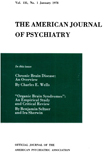COMPLICATIONS IN ELECTRIC SHOCK THERAPY
Abstract
Therapeutic electric shocks produce some reversible cortical changes, probably together with some irreversible neuronal degeneration and gliosis. The typical memory losses are generally recoverable, and the diversified EEG disturbances tend to disappear in several months.
According to reports in the literature, the neuronal discharge may have other effects than the intended grand mal: cardiac arrest, autonomic disorders, status epilepticus, or manic delirium.
Regardless of operating technique, reported rate of compression fracture of a vertebral body vary from 0.5 percent of cases, to 20 percent with routine X-raying. Many compressions will remain undiscovered unless spines are routinely X-rayed post-shock. Compression spinal fractures are clinically inconsequential. The humerus, or more rarely some other bony structure, is occasionally fractured; to these instances the technique of shocking seems relevant.
Dislocation at the shoulder or mandibular joint should be technically preventable.
Arterial hypertension may be aggravated by electroshock, and myocardial insufficiencies can lead to a fatal outcome. Curare attenuates the convulsive violence but may add new dangers; its drawbacks are still under scrutiny.
Aspiration during the coma has been deemed responsible for complicating lung abscesses. Liability to pulmonary complications probably has other unknown causes. Post-shock pneumonias have not always been charged to the therapy. The published mortality rates appear over-optimistic.
Access content
To read the fulltext, please use one of the options below to sign in or purchase access.- Personal login
- Institutional Login
- Sign in via OpenAthens
- Register for access
-
Please login/register if you wish to pair your device and check access availability.
Not a subscriber?
PsychiatryOnline subscription options offer access to the DSM-5 library, books, journals, CME, and patient resources. This all-in-one virtual library provides psychiatrists and mental health professionals with key resources for diagnosis, treatment, research, and professional development.
Need more help? PsychiatryOnline Customer Service may be reached by emailing [email protected] or by calling 800-368-5777 (in the U.S.) or 703-907-7322 (outside the U.S.).



